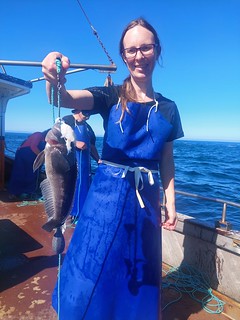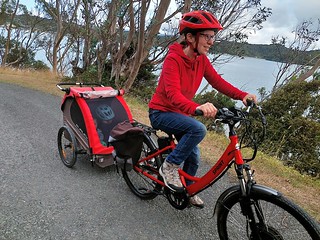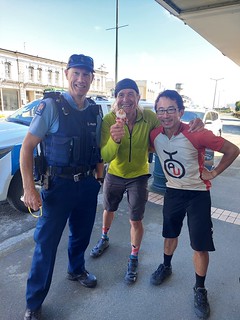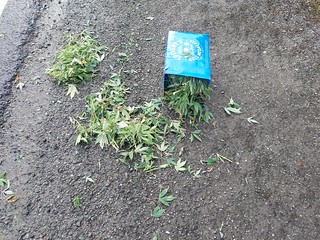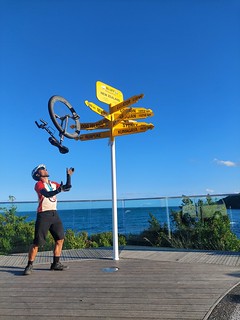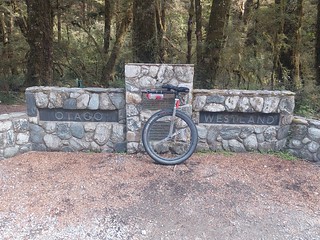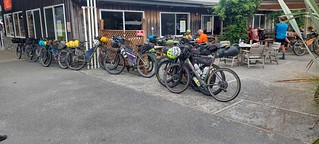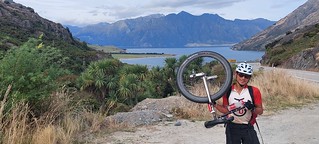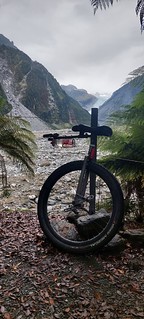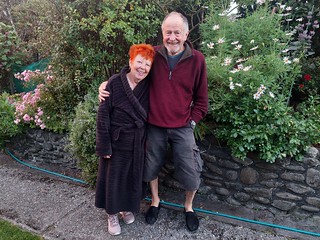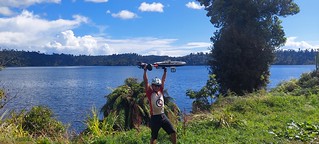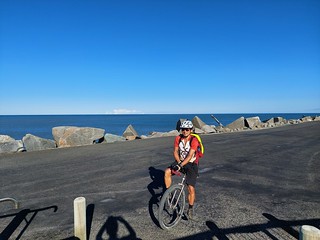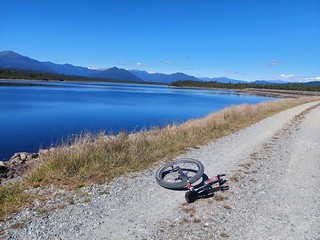The first thing I discovered about Tour Aotearoa is that the more stuff you carry, the harder it is. I ended up dropping a lot of excess gear (thanks to Mike Holland and Bryan Page, for posting them back to me!)
Packing list (crossed off items removed):
29″ Triton unicycle
Lowe Alpine Aeon 35L pack
3L hydration bladder
Unicycle.com carabiner
Macpac raincover replaced with Oxford reflective cover after North Island
Giro Radix MIPS helmet
Ergodyne sun brim
Dry bag and spare bags
Packable grocery bag
2x N95 and 2 surgical masks
6 clothes pegs
2 tent pegs
Duct tape
Rag and oil soaked rag
Leatherman Wave multitool
Gerber Cool Tool main tool removed, kept allen keys only
Ground Effect tool wallet
Lezyne pump
Toiletries- Colgate bamboo toothbrush, Gilette Fusion razor (handle removed, kept the blade only), 1/3 sensodyne tube, 3/4 Palmolive shave foam, bar of soap
Cocoa butter, sunscreen and insect repellent (Picaridin based)
spare tube and puncture kit
spare 4x AAA Energiser Lithium batteries for spot tracker
North and South Island Tour Aotearoa guide books replaced with PDF version on phone
Selfie stick what was I thinking???
Oakley Chamfer prescription sunglasses, Oakley Crosslink glasses, spare pair of old glasses
Lumia 500L bike light (replaced with lighter and brighter Giant Recon HL1100, Lumia helmet front/rear light, Knog Cobbler back light
Cables for charging
Cygnett 20,000mAmph/hr powerbank
Forty2 gloves
DHB Arm warmers, unknown pair arm sun guard sleeves
DHB Leg warmers
Route 7 ear warmers
North Face zip off cargo pants
Thermatech top
Adventure Unicyclist, Triple-0 and Louis Garneau cycling tops
Tour Aotearoa T-shirt
Fox ranger cycling shorts
Arsuxeo cycling shorts
2x 1x bike short inners (NZO active)
Underwear x 3 (x1)
Polyprop thermals
Kathmandu merino socks, Kathmandu Coolmax socks, Thorlo thin calf length ski socks
Mountain Warehouse Curlew shoes
Mac In a Sac Neon jacket (10,000mm/8000gsm)
Outdoor Research Helium Bivvy
Black Wolf Hiker 200 down sleeping bag (+8C comfort, 3C lower limit, -11c extreme)
Silk Sak sleeping bag liner
Macpac large pack towel
Wallet 2x bank cards, driver licence, 1x credit card
Samsung A52 phone
Kennett Bros Tour Aotearoa NI and SI guidebooks (swapped to PDF version on phone)
Total unicycle weight: 5.1kg
Total pack weight (without food/water): 8.6kg 5.1kg
Dropping 3.5kg made a huge difference to my long distance comfort- I was no longer getting sore shoulders, and I could last much longer in the saddle. I carried up to 2 x 750mL water in the pack, and a 750mL water bottle on the unicycle. On days with minimal water/ food stops (eg Big River trail, Queenstown to Mossburn), I carried 2x 1.5L water in my pack, and up to 500g food. In the first few days of riding, I drank far more than I could carry, but as we went further south, the weather became cooler and I ended up with excess water.
I was able to wash my riding clothes most days, which would dry overnight, so there is little need to have 3 cycle jerseys and 2 cycling shorts! I kept a second pair of socks, but it wasn’t necessary. It’s important to have non-riding ‘civilian’ clothes if you want a meal at the pub with clothes on, so I kept a pair of trousers and my Tour Aotearoa t-shirt. The pack towel is nice, but if you are staying in motels/hotels one is usually provided. Even when it isn’t, shaking yourself dry in 5min is preferable to carrying an extra 100g over 3000km.
I used the bivvy/sleeping bag on a couple of occasions, but my goal was to complete the TA under brevet rules, which is under 30 days. Some riders aim to be as self sufficient as possible, but I had to compromise on camping. In order to ride 100km+/day, it is important to have a good sleep/rest, so I stayed mainly in hotels/motels/B&B. The bivvy/sleeping bag was insurance- there were times where I considered sleeping on the side of the road because I didn’t think I would reach my accommodation. It could easily happen with mechanical issues, injury, or underestimating the time/difficulty of a particular section.
My primary navigation device was my Samsung A52 phone, running on the Vodafone network, which I also used to write this blog with! There are many areas in NZ with poor cellphone reception. Some riders have found the Spark cell network more extensive, so it may be worth having dual sim cards for the trip.
My android GPS app was Osmand, which has excellent offline capability. I had trouble getting it to follow the TA GPS track (it would make its’ own preferred cycle route), but it was otherwise easy to navigate- just make the blue dot follow the red line. If only high school orienteering had been this simple!
The Kennett Bros TA guidebooks are invaluable, but I ditched the books for the PDF version to save extra weight. It gives you navigation advice as well as tips like where food/water stops are. For speed/distance, I used an 8yr old Garmin Edge 200 cycle computer, which runs on GPS but has no navigation capability. With the combination of Osmand, TA guidebooks and cycle computer, my only navigation error was on Day 2, where I missed my accommodation by 2.5km because I cycled past it in the dark.
I used a 20,000mAmp/hr powerbank, but could have gotten by with 10,000mAmp/hr unless camping. My helmet mounted headlight worked poorly on gravel- the best place for a light is on on your handlebars because it casts a shadow over rocks/corrugations, giving you depth perception. A light above your head makes everything look 2 dimensional. I sent the more powerful bar mounted light home to save weight, but then picked up another when I reached Wellington. By then, my routine was pretty well sorted, so I didn’t end up riding much in the dark. For rear lighting- the 270 lumen Knog Cobbler has 330 degree cover and can be seen easily during the day. I turned it on for all busy roads/state highways. The other item I’m very pleased with is the Oxford bag cover. It is marginally small for my 35L pack, but has great visibility both day and night.
The 29″ Triton unicycle performed well, although swapping to a longer KH handlebar (after the North Island) helped spread the load and improved long distance comfort. The water bottle mount was helpful- it reduced the amount of water carried in my pack, and could be accessed while riding. I replaced my bearings at the end of the North Island, but should have started the ride with fresh bearings. The Triton titanium frame was flawless, and the only thing I didn’t have to worry about. My Vittoria Mezcal III tyre rolled well both on and off-road, with no punctures, but it may be worth going tubeless with sealant to reduce puncture risk further. The Nimbus VCX triple hole cranks (100/125/150) was lighter than carrying spare cranks/extractor but I only used 100mm for on-road and 125mm for off-road. On a 29″ ungeared unicycle, it would be good to have an 89mm option for flat riding, but there are no triple hole cranks with 89mm. The entire rig was very light (5.1kg without water), climbed well and handled off-road sections with little difficulty. I could attach equipment/bags to the unicycle, but would not want more than 2-3kg. There are tricky sections which cannot be fun on a fully laden unicycle…consider TA to be more a unipacking trip than a unitour.

